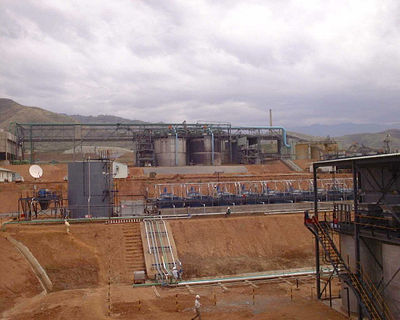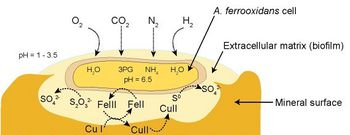Copper Mining Using Acidothiobacillus: Difference between revisions
GipsonAndrew (talk | contribs) No edit summary |
GipsonAndrew (talk | contribs) No edit summary |
||
| Line 37: | Line 37: | ||
[http://journals.ohiolink.edu/ejc/pdf.cgi/Mignone_C.F.pdf?issn=1369703x&issue=v18i0003&article=211_arfgamoib Mignone CF and Donati ER (2004)ATP requirements for growth and maintenance of iron-oxidizing bacteria. ''Biochemical Engineering Journal'' '''18''': 211–216.]<br> | [http://journals.ohiolink.edu/ejc/pdf.cgi/Mignone_C.F.pdf?issn=1369703x&issue=v18i0003&article=211_arfgamoib Mignone CF and Donati ER (2004)ATP requirements for growth and maintenance of iron-oxidizing bacteria. ''Biochemical Engineering Journal'' '''18''': 211–216.]<br> | ||
Rawlings DE (2002) Heavy metal mining using microbes. ''Annu. Rev. Microbiol.'' '''56''': 65-91.<br> | Rawlings DE (2002) Heavy metal mining using microbes. ''Annu. Rev. Microbiol.'' '''56''': 65-91.<br> | ||
[http://www.biomedsearch.com/ | [http://www.biomedsearch.com/nih/Acidithiobacillus-ferrooxidans-metabolism-from-genome/19077236.html Valdés J, Pedroso I, Quatrini R, Dodson RJ,Tettelin H, Blake R, Eisen JA, Holmes DS (2008) Acidithiobacillus ferrooxidans metabolism: from genome sequence to | ||
Tettelin H | |||
industrial applications. ''BMC Genomics'' '''9''': 597.] | industrial applications. ''BMC Genomics'' '''9''': 597.] | ||
Revision as of 02:54, 26 April 2011

Introduction
By Andrew Gipson
Other examples:
Bold
Italic
Subscript: H2O
Superscript: Fe3+
Introduce the topic of your paper. What microorganisms are of interest? Habitat? Applications for medicine and/or environment?
Section 1
Include some current research, with at least one figure showing data.
Mechanism of Bacterial Leaching
Copper is not a metabolite of At. ferrooxidans, so the bacteria is not directly responsible for the solubilization of copper. Rather, it occurs through an abiotic reaction between the copper ores and the ferric ions and protons produced by the metabolic activities of the bacteria.
Bacterial Metabolic Reactions
At. ferrooxidans has a diverse set of metabolic processes that allow it to be lithoautotrophic, but the most economically important activity this bacterium performs is the oxidation of ferrous iron (Fe2+) to ferric iron (Fe3+):
...and the oxidation of elemental sulfur (So) to sulfuric acid (H2SO4):
Abiotic Solubilization and Regeneration of Bacterial Substrates
Section 3
Include some current research, with at least one figure showing data.
Conclusion
Overall text length at least 3,000 words, with at least 3 figures.
References
Iasillo E (1999) Metallurgical test program for copper leaching projects. In Copper Leaching, Extraction, and Electrowinning Techniques, ed. Jergensen GV. 124-128. Littleton: SME.
Leduc LG and Ferroni GD (1994) The chemolithotrophic bacterium Thiobacillus ferrooxidans. FEMS Microbiology Reviews 14:103-120.
Mignone CF and Donati ER (2004)ATP requirements for growth and maintenance of iron-oxidizing bacteria. Biochemical Engineering Journal 18: 211–216.
Rawlings DE (2002) Heavy metal mining using microbes. Annu. Rev. Microbiol. 56: 65-91.
[http://www.biomedsearch.com/nih/Acidithiobacillus-ferrooxidans-metabolism-from-genome/19077236.html Valdés J, Pedroso I, Quatrini R, Dodson RJ,Tettelin H, Blake R, Eisen JA, Holmes DS (2008) Acidithiobacillus ferrooxidans metabolism: from genome sequence to
industrial applications. BMC Genomics 9: 597.]
Edited by student of Joan Slonczewski for BIOL 238 Microbiology, 2011, Kenyon College.

